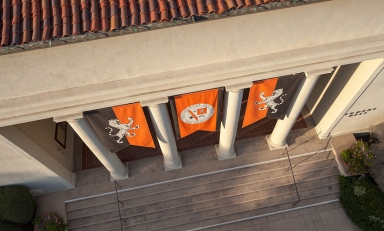On April 18, a group of Occidental College students presented a Web project on the history of Los Angeles graffiti, car, and skateboard culture as part of the College's Spring Arts Festival and Street Culture Series.
The "Oxy Street Art Project," timed to coincide with the Museum of Contemporary Art's "Art in the Streets" exhibit, was unveiled at a reception at the Outpost for Contemporary Art in Highland Park, 1268 N. Avenue 50, Los Angeles. Student artists and researchers also created silk-screened t-shirts of several Oxy Street Art designs for free.
The historical research project focuses on six places in the city where graffiti and Angelenos' obsession with the automobile and skateboard bloomed: the Belmont tunnels (graffiti art); Venice Beach (skate culture); the Los Angeles River (graffiti art), Whittier Boulevard (car culture); Pan Pacific Auditorium (graffiti art); and Hollywood High School (skate culture). The green-and-white Pan Pacific Auditorium, for instance, once admired for its Streamline Moderne architecture, was the canvas for many graffiti artists after the building fell into disuse in the early 1970s.(It burned down in 1989.) Hollywood High has long been a popular place for amateur and professional skateboarders because of the school's challenging stairs, easy campus access, and the largely benign attitude of the school's security detail.
Because of L.A.'s freeway system and the use of the River as a flood control channel, the city's unique urban landscape is marked by massive concrete walls, bridges, and overhead ramps, especially in lower-income neighborhoods. "Street art is a creative, expressive response to feeling shut out by not only these concrete edifices but also the social structures of poverty, racial prejudice, and inferior opportunity," said Katie Mills, visiting assistant professor of art history and visual arts and co-director of the project with associate art history and visual arts professor Amy Lyford. "It has a vibrant and elaborate heritage that is passed on as new generations speak out about identity, community, and resistance to power hierarchies."
Six Occidental students conducted independent research on this semester-long project: Auddie Benavides '12, Karina Brioukhova '11, Parker Harris '11, Elsa Henderson '13, Zoe Walsh '11, Kat McLain '13. Through Occidental's Center for Community Based Learning Educator in Action program, Robert McConnell '11 also participated. Their research produced videos, historical photos, websites, and interviews of some of Los Angeles's graffiti artists and skaters. They include Craig Stecyk, who helped define the surf-skate-punk-graffiti culture of 1970s Venice as one of the founders of the famous Zepher Skate Team; urban muralist Man One; and photographer Gusmano Cesaretti, who has published two books on graffiti art.
"The aim of the Oxy Street Art Project is for students to produce and share their research on significant locations within Los Angeles' street art culture, visiting issues of urban space, artistic expression, power, and free speech," said Mills. "Then this interactive online resource will be open to people who want to contribute their own stories and images about local street art."
It's no accident that the street art project was presented at the same time as MOCA's "Art in the Streets" exhibit. Occidental has been forging connections with MOCA for the past several years. Aandrea Stang, the museum's senior education program manager, is teaching an art course at Occidental this semester. Aaron Rose, MOCA's co-curator for its street art exhibit, helped shape the students' project by suggesting the sites to research, and invited them to the opening reception of the MOCA exhibit, which will run April 17 through August 8.
The reception for the Oxy Street Art Project was also part of the College's second annual Spring Arts Festival, April 12-18, as well as of Oxy's Street Culture Series, a compendium of music, spoken word, theater, and video and film events in April centered on speech, identity, and the public sphere. The series is sponsored by Occidental's Remsen Bird Fund, the departments of Art History and Visual Arts, Music, and Theater, Center for Digital Learning and Research, Center for Community-Based Learning, Intercultural Community Center, and the president's office.



